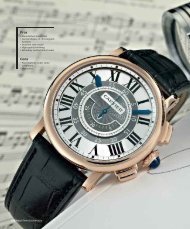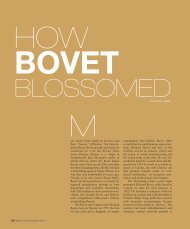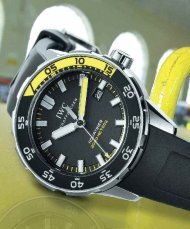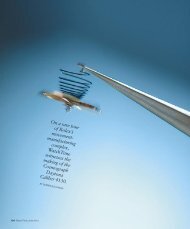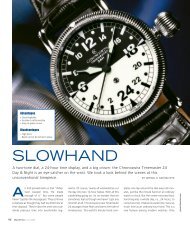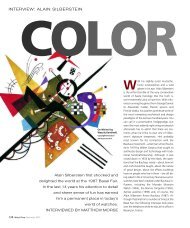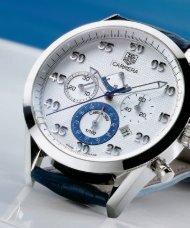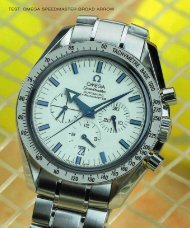pro & con: horizontal vs. vertical coupling - WatchTime
pro & con: horizontal vs. vertical coupling - WatchTime
pro & con: horizontal vs. vertical coupling - WatchTime
Create successful ePaper yourself
Turn your PDF publications into a flip-book with our unique Google optimized e-Paper software.
PRO & CON: HORIZONTAL VS. VERTICAL COUPLINGtact between the teeth of the two gears makesthem wear out faster. Watchmakers try to alleviatethis <strong>pro</strong>blem by giving each tooth a triangular<strong>pro</strong>file and by cutting a large number offinely spaced teeth around the rim of thechronograph’s center wheel. The advantagesof the elaborate wheel-<strong>coupling</strong>system include its relativelyflat height and, above all, a visuallyappealing mechanism.The chronograph’s se<strong>con</strong>ds hand (below) onPatek Philippe’s calendar chronograph (bottomright) can also be used as an ordinary se<strong>con</strong>dshand. There is no separate and <strong>con</strong>tinuouslyrunning se<strong>con</strong>ds hand.A Simpler SolutionA <strong>coupling</strong> system thatEdouard Heuer registered forpatent <strong>pro</strong>tection on ChristmasEve in 1886 is <strong>con</strong>siderablysimpler. The so-called“rocking pinion” is a moveablymounted arbor with two s<strong>pro</strong>ckets.One s<strong>pro</strong>cket, affixed to thedial side, meshes directly with thefourth wheel of the movement. The oppositeone, into which fine teeth have beencut, pivots through a small arc and engageswith the chronograph’s center wheel after thestart button is pushed. When the <strong>con</strong>nection ismade, the chronograph hand begins to run.This mechanism eliminates the need for a drivingwheel and an intermediate wheel. Whenthe button is pressed again, the rocking pinionpivots away from the chronograph’s centerwheel, dis<strong>con</strong>necting it from the flow of forceand halting the motion of the chronographhand. This system was first used in wristwatchesin 1946. In an effort to <strong>pro</strong>duce a more e<strong>con</strong>omicalversion, Valjoux <strong>con</strong>structed columnwheelCaliber 77 ECO with a rocking pinion. Acurrent example of this not-especially-eyecatching<strong>coupling</strong> version is the well-knownand widely used ETA Valjoux 7750.An entirely different type of <strong>coupling</strong> wasdevised by Manufactures des Montres &Chronographes Pierce S.A., a firm founded inBienne, Switzerland in 1883. This companylaunched its Caliber 130 in 1936. Pierce wasforced to develop its own movement becauseit could no longer obtain movement blanksfrom the classical ébauches factories. Necessitybecame the mother of invention, and PierceVERTICALPHILIPPE STERNPRESIDENT OF PATEK PHILIPPE:“A <strong>vertical</strong> disk <strong>coupling</strong> between the<strong>con</strong>tinually turning axis of the fourthwheel and the pinion of the chronograph’shand allows an interruption ofthe flow of force to the chronographcounters without the need for interruptingthe rotation of the fourth wheel. Atthe same time, this eliminates the dangerof a jump or retrograde motion by thehand because no teeth need to meshwith one another. A <strong>con</strong>ventional solutionwith three chronograph wheels increaseswear. This does not occur in our<strong>coupling</strong>, so the chronograph hand canalso be used as an ordinary se<strong>con</strong>ds handwithout adversely affecting the rate ofthe movement, without reducing thepower reserve and without causing increasedwear.”90 <strong>WatchTime</strong> April 2007



